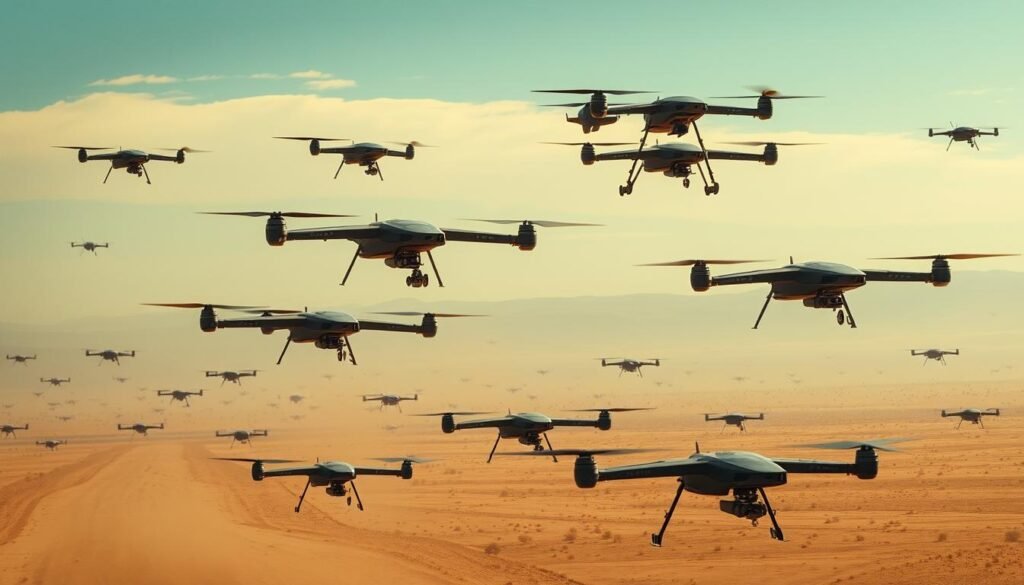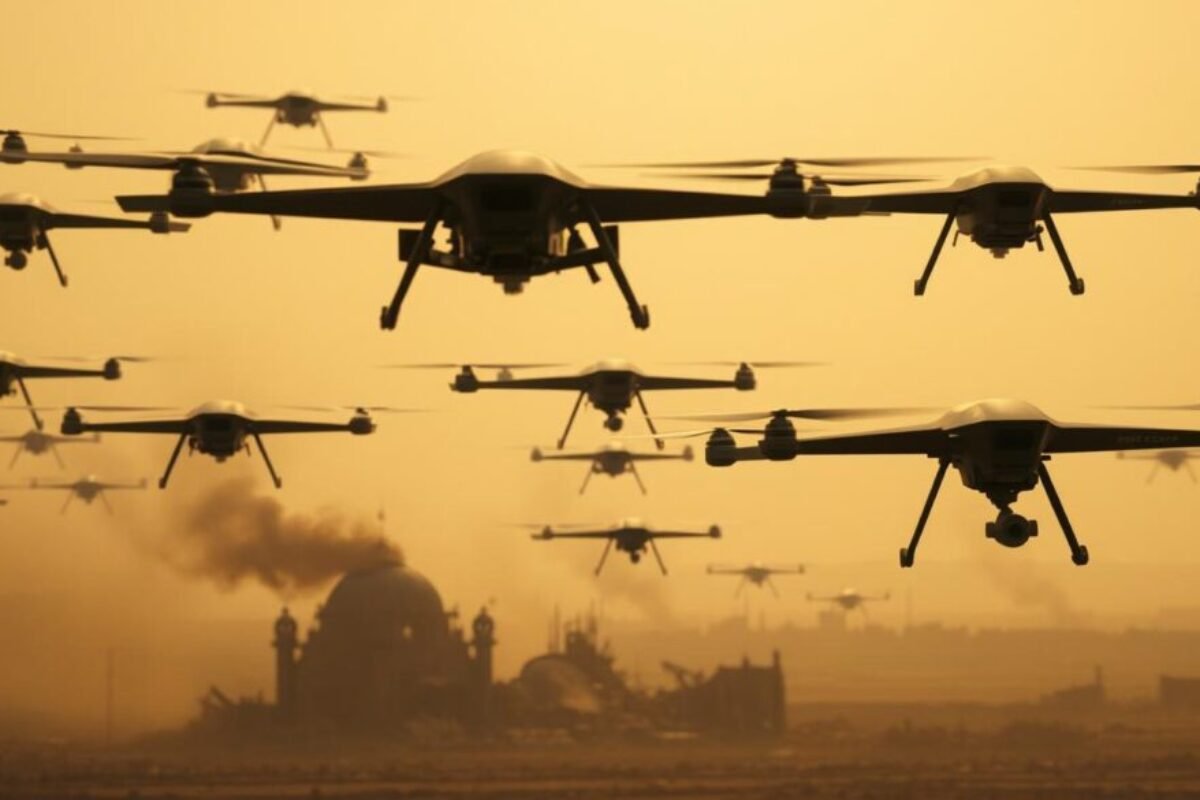Drones and Asymmetric Warfare: Shaping the Future of Conflict.
By mid-2024, over 50,000 unmanned aerial vehicles (UAVs) were in use. This number changed how armies see using force and taking risks. It shows drones and asymmetric warfare are now key parts of modern battles.
The shift to drones and asymmetric warfare is big. Now, small drones and long-range munitions are as important as big guns and missiles. In places like Ukraine and Israel, drones are giving real-time info and precise attacks, keeping soldiers safer.
For the U.S., knowing about drone tech is a must. With cheap parts, easy production, and AI, enemies can make drones fast. This changes how the U.S. plans to defend itself and its allies.
Key Takeaways
- Drones and Asymmetric Warfare have scaled rapidly—tens of thousands of UAVs affect modern combat dynamics.
- The drone revolution and asymmetric warfare blend surveillance and strike roles into affordable, distributed systems.
- Operation Sindhoor and conflicts in Ukraine and Israel illustrate real-time ISR and precision effects with minimal ground risk.
- Low-cost drone technology enables grassroots innovation and forces shifts in defense budgets toward countermeasures.
- U.S. strategy must adapt to decentralized production, AI integration, and evolving ethical and legal challenges.
The Drone Revolution and Asymmetric Warfare
Small, cheap systems have changed how armed groups and states plan. The drone revolution and asymmetric warfare show a shift. Now, commanders weigh risks against the benefits of unmanned platforms.
Defining the drone revolution
The drone revolution is based on three key points: affordability, decentralization, and adaptability. With off-the-shelf parts and open-source software, anyone can make effective drones quickly. This makes drone warfare more accessible to more people.
How unmanned aerial vehicles (UAVs) altered asymmetric warfare tactics
UAVs have changed how forces operate. Small teams use drones for scouting, marking targets, and strikes. This approach reduces the need for large troop deployments.
FPV drones and loitering munitions allow for precise attacks on key targets. This strategy emphasizes speed and surprise over brute force. Defenders must now protect soft targets and set up air defenses over wider areas.
Case evidence from recent conflicts: Ukraine and Israel
In Ukraine, drones were turned into battlefield tools by the Army of Drones and hobbyists. By mid-2024, there were thousands of drone sorties. Ukrainian forces used drones to disrupt supply lines and ports.
Israel employs drones for surveillance and strikes. Their experience shows how drone warfare changes the pace and targets of combat. Russia’s use of similar drones shows how adversaries adapt to these new tools.
Why drones became central to modern warfare strategies
Drones changed how battles are planned and fought. Now, small teams can do what used to need big groups or expensive weapons. This change made military leaders rethink how they use resources and plan their forces.
Cost-effectiveness versus traditional munitions
FPV units and quadcopters are cheap, costing just a few hundred dollars. They can do jobs that used to need expensive missiles. This makes drones a cost-effective choice for military operations.
Operation Sindhoor showed drones’ value in reducing soldier risk and limiting conflict. Military planners now consider drones’ lower cost against the high cost of old systems when planning their forces.
Force multiplication in low-intensity and cross-border operations
Small units can now reach and harm enemies more thanks to drones. In Ukraine, cheap drones helped balance out Russian numbers. Sea drones also changed naval strategies and coastal defense.
Drones help cut off enemy supplies, target important areas quickly, and disrupt operations. This is key in small fights and border clashes where quick, agile tactics are more effective.
Real-time intelligence, surveillance, and reconnaissance advantages
Having constant eyes on the battlefield changes how decisions are made. Quick intelligence lets commanders check their actions, adjust plans, and reduce harm to civilians. This makes operations faster and safer.
Today, constant ISR from drones is part of modern warfare. Military leaders must balance drone purchases with investments in defense and electronic warfare to keep a strong defense.
Types of drone technology changing battlefields
Today’s battlefields are filled with unmanned systems. Small, fast drones and larger strike platforms work together. They create complex effects on the battlefield. Each type has its own strengths and weaknesses.
First-person view attack craft and expendable strike vehicles
FPV drones send live video to the pilot. This allows for precise attacks in tight spaces. They are built from racing parts, making them cheap and quick to use.
Expendable drones are fast and carry a warhead. They are perfect for quick, tactical strikes. Their small size makes them easy to use in the field.
Long-range strike platforms and attrition-focused munitions
Long-range drones can hit strategic targets far away. They fly high and stay in the air longer. This forces defenders to stretch their defenses.
Loitering munitions, like the Shahed-style systems, aim to wear down defenses. They hit fixed targets and deny areas. Countries like Russia use these drones for long-range attacks.
Persistent ISR, maritime drones, and ground robotics working together
Surveillance drones provide constant intel. They help plan attacks for other drones. Light drones like the Skylark family can stay in the air for a long time.
Maritime drones have changed sea battles. Small drones like Ukraine’s Sea Baby can threaten big ships. They force ships to change their patrol routes.
Ground robots do different jobs on land. They help with logistics, clear mines, and even attack. They work with aerial sensors to improve teamwork in battles.
There’s a wide range of drones out there. From small attack drones to big surveillance ones, and even ground robots. Commanders use these drones to fit their mission needs. This changes how battles are fought in the future.
Operational case study: Operation Sindhoor and lessons learned

Operation Sindhoor was a drone operation by the Indian Armed Forces from May 7–10. It’s a great example of how to handle low-intensity conflicts today. They used drones to watch and attack Pakistani spots along the Line of Control, all without stepping foot on the ground.
The operation mixed drones, artillery, and missiles to get more power. They used real-time information from drones to pick their targets. This way, they hit only the right spots, causing damage and losses to the enemy.
This case study shows how careful, precise attacks can be very useful. The Indian forces hit their targets without starting a big fight. This kept their soldiers safe and didn’t harm many civilians.
Important lessons from this operation include setting clear rules for drone use. It’s key to know who to target and when to stop. Legal and diplomatic issues also played a big part in deciding when to use drones.
For the U.S., Operation Sindhoor teaches valuable lessons about fighting in a smart way. Using drones wisely can help deal with threats at the border. The U.S. should think about how to use drones carefully, considering who to target and how to avoid big problems.
| Aspect | Operational Detail | Lesson |
|---|---|---|
| Force Mix | Drones paired with artillery and missiles for targeted strikes | Combine systems to amplify precision while limiting footprint |
| ISR Capability | Persistent UAS surveillance enabled rapid targeting | Real-time data is critical for minimizing collateral effects |
| Escalation Control | Limited strikes avoided full-scale retaliation | Rules of engagement and political framing matter as much as kinetic effect |
| Legal/Political Risk | Cross-border actions required diplomatic management | Clear attribution and legal review reduce political blowback |
| Applicability to U.S. | Model for measured use against proxy actors in border contexts | Develop doctrine on proportionality, attribution, and escalation |
FPV drones on the front lines: Ukraine and Israel experiences
In Ukraine and Israel, small FPV drones are making a big impact. They allow for precise strikes at a low cost. Pilots can get close to targets thanks to live video feeds, which also reduces damage to others and shortens training.
These drones are also praised for their speed and accuracy in tactical missions. They are a valuable asset on the battlefield.
Engineers have worked hard to make these drones work in areas with lots of electronic interference. They use GPS-independent navigation and high-gain antennas. Some even add image-based guidance and radios that change frequency to avoid jamming.
Electronic warfare is a big challenge in modern battles. Armies use vehicle-mounted domes and portable jammers to fight off drones. But these measures use a lot of power and only block certain frequencies, leaving room for drones to adapt.
Combat shows the complex trade-offs involved. EW can make many systems unusable in intense battles. But defenders are finding ways to keep drones flying, even when links are lost.
Teams are constantly improving their drones. They test new navigation systems, AI for finding targets, and ways to keep communications open. The goal is to keep drones effective, even when faced with electronic warfare.
| Aspect | Frontline Challenge | Typical Adaptation |
|---|---|---|
| Guidance loss | GPS denied by jammers | GPS-independent navigation using INS and vision |
| Link jamming | Frequency saturation and targeted interference | Frequency-hopping radios and short-burst telemetry |
| Power constraints | High consumption of vehicle-mounted domes | Lightweight omnidirectional backpack jammers for squad use |
| Autonomy | Comms drop during approach | Onboard image-recognition and limited mission autonomy |
| Operational tempo | Rapid attrition under heavy EW | Fleet-level redundancy and rapid hardware swaps |
Decentralized innovation and the rise of grassroots drone ecosystems

In Ukraine, we see how decentralized innovation changes wartime production. Local businesses, startups, and volunteers moved from quick fixes to organized supply chains. This change created a system where small makers and big suppliers work together to make things fast.
H3: Ukraine’s Army of Drones and rapid startup-driven production
The Army of Drones network linked over 200 companies to share parts, designs, and funds. Crowdfunding and NATO help sped up getting things. Private teams made quick prototypes. This teamwork made thousands of drones and let startups test new designs in days.
H3: COTS modification, 3D printing, and agile field iteration
Teams used COTS modification to make hobby drones ready for missions. 3D printing made custom parts fast. Modular designs let field teams test and update drones easily.
H3: Implications for U.S. allies and partner training models
Allies must choose between one big supply chain or many small ones. Good training includes hands-on learning, maintenance, and tactics learned in action. Training that mirrors real-world experiences helps teams adapt and fight off electronic threats.
| Area | Grassroots Strength | Allied Adoption Priority |
|---|---|---|
| Production Speed | Startups and volunteer labs produce prototypes in days using 3D printing | Build local rapid-prototyping hubs for urgent needs |
| Cost | COTS modification reduces expense by converting off-the-shelf parts | Integrate COTS strategies into procurement to lower unit cost |
| Training | Field-driven operator lessons and peer-to-peer coaching improve combat use | Emphasize partner training that blends classroom and live iterative practice |
| Supply Chain | Distributed suppliers and makers create redundancy and speed | Develop distributed manufacturing nodes and shared logistics |
| Resilience | Adaptive fixes and modular parts support rapid repair under fire | Prioritize EW resilience, hardening, and maintenance in training curricula |
Drone technology advancements and AI integration
Recent upgrades in unmanned systems combine machine learning with strong hardware. Platforms like Lancet-3 and Ukraine’s Delta and Saker Scout use neural nets for decisions. These changes move missions from remote control to more autonomy, but also show new limits.
Autonomy, target recognition, and swarm tactics
Autonomy means less need for constant control from the ground. When communication fails, some drones use local image processing. This helps them navigate and recognize targets, reducing mission failures in tough skies.
Swarm tactics use many small UAVs to overwhelm defenses. NATO’s Replicator and similar projects aim to make these groups work together for tasks like blocking areas and gathering intel.
AI-enabled loitering munitions and semi-autonomous engagement
Loitering munitions now have classifiers to pick targets before a human decides. This semi-autonomous approach speeds up the time from seeing a target to taking action. It keeps a human involved in deadly decisions.
Challenges in verification, reliability, and battlefield ethics
Verification is a big issue. Misclassification has led to disputed strikes and claims of harm to civilians. The quality of software varies, making reliability a concern, even under attack.
Ethical problems include control, responsibility, and being open. Laws haven’t kept up with the fast growth of drones. Military lawyers and policy teams in the US and its allies are under pressure to figure out who’s accountable for AI actions.
Counter-drone developments and the electronic warfare arms race
Electronic warfare has become key in drone survival. Systems like Russia’s Borisoglebsk-2 and Krasukha-4 can disrupt drone control links. This has led to 30–40% of drone losses in battles, changing tactics.
Defense planners now use a mix of methods to protect drones. They use kinetic interceptors, jamming systems, and hardened navigation. Vehicle-top domes and backpack jammers block control frequencies for short ranges.
Forces are using frequency-hopping and new control bands to counter these measures. This is a race to keep up with counter-drone technology.
Companies like Epirus are making tactical jammers for mobile units. Israeli efforts, including Iron Beam, are testing directed-energy. These efforts help in quick updates to counter-drone tools.
Navigation hardening is also a focus. Inertial measurement units and optical navigation aids are being developed. These aim to reduce GPS reliance, making drones harder to spoof or jam.
Tactical suites combine sensors, EW suites, and interceptors for defense. Commanders prefer a mix of soft-kill and hard-kill options. Jamming systems give time for kinetic assets to act, while directed-energy offers low-cost defense in high-threat areas.
The electronic warfare arms race is fast-paced. As counter-drone tools improve, drone designers are making them stealthier and more autonomous. The cycle of attack and countermeasure is getting shorter, with survival depending on quick integration of EW capabilities.
Strategic impact on national security and force posture
The rise of low-cost drones makes militaries rethink their strategies. Operation Sindhoor showed that drone strikes can apply pressure without starting big wars. This changes how countries show their strength.
How affordable UAVs change deterrence and escalation calculus
Small drones can challenge big militaries. Ukraine’s use of drones in recent conflicts shows that cost can beat size. Now, defense is not just about having the best tech, but also about handling constant attacks.
Redistribution of defense budgets toward countermeasures and EW
Defense budgets are shifting to electronic warfare and defenses. NATO and the U.S. are investing in jamming and hardened systems. It’s a balance between new tech and countermeasures to stay ahead.
Implications for U.S. homeland defense and allied planning
U.S. homeland faces threats from drones, like in the Red Sea. Defense needs better detection, laws for stopping drones, and quick countermeasures. Allies should work together on training, resilience, and EW to keep up with drone threats.
Ethical, legal, and accountability challenges with autonomous systems

The use of autonomous systems in war raises big questions about who is responsible. Military leaders, lawyers, and politicians must think about the risks and benefits of AI in war. They need clear rules and technical checks to avoid confusion.
Ambiguities of responsibility for AI-driven strikes
When an AI system like Lancet-3 or Saker Scout makes a mistake, who is to blame? It’s not just one person. Everyone involved, from the operators to the makers, has a role. But, the current system doesn’t always hold anyone accountable.
Field tests show that AI can make mistakes and cause harm. Without good records and checks after a strike, figuring out who’s at fault is hard.
International law gaps and calls for regulation of autonomous weapons
The United Nations has no clear rules for AI weapons. Talks at the UN Convention on Certain Conventional Weapons show concern, but no agreement on strict rules.
Many people and some governments want stricter rules to protect civilians. They suggest things like export controls and shared checks to follow international law.
Policy choices for the United States: restraint, norms, or lead in regulation
The U.S. has three main options. It could limit AI use in war, work to set global standards, or push to lead in AI development with safety measures.
Each choice has its own effects on alliances, partners, and the U.S.’s reputation. Tools like human checks, audits, and reporting can help bridge the gap between ethics, law, and war.
| Policy Path | Core Measures | Likely Legal Effects | Operational Trade-offs |
|---|---|---|---|
| Restraint | Limits on autonomous targeting, human-in-loop mandates, export curbs | Reduces legal ambiguity, aligns with existing international law | Slower tech adoption, tactical disadvantages |
| Norms and Leadership | Diplomatic initiatives, shared standards, verification regimes | Strengthens international law, sets common expectations | Requires coalition-building, long timelines |
| Capability First with Safeguards | Rapid development, robust auditability, transparency measures | Attempts to balance innovation with responsibility under law | Risk of export proliferation, harder to reassure partners |
Comparative national approaches: scalable cheap systems versus sophisticated platforms
The world of unmanned warfare has split into two paths. One focuses on making lots of drones quickly and cheaply. The other aims for drones that are more advanced and can work together better. Both ways have their own challenges for staying effective on the battlefield and keeping their industries strong.
The Ukraine model is all about making lots of drones fast. Over 200 companies, volunteer groups, and crowdfunding helped Ukraine make thousands of drones quickly. They used parts from stores and 3D printing to make drones that could be fixed easily and flown often.
Russia, on the other hand, is making more advanced drones. They have teams working on drones with better sensors and AI. But, sanctions and supply chain issues have slowed down their production, causing problems with quality and numbers.
Both Ukraine and Russia face similar problems. Drones can be affected by jamming signals and supply chain issues. Making lots of drones can hide problems, while making advanced drones can limit how many you can make. Leaders have to decide between drones that last a long time and those that are very precise.
NATO is learning from both sides. They want to work with many suppliers and have places where new drone ideas can be tested quickly. They also want to keep making advanced drones but also make lots of simpler drones for battles that last a long time. They need to make sure they can make parts like motors and special electronics.
NATO should help startups by buying from them regularly and making it easier to test and use new drone upgrades. Working with big companies like Lockheed Martin and Airbus can help fix supply chain problems. This way, NATO can give drones to its allies that are both strong and can be made in big numbers.
| Characteristic | Ukraine model | Russia model | Implication for NATO |
|---|---|---|---|
| Production approach | Decentralized, hundreds of small firms and volunteers | Centralized, state-run design bureaus and defense firms | Support mixed supply networks to balance speed and control |
| Unit cost | Low per-unit cost, high expendability | Higher cost, feature-rich platforms | Maintain low-cost options for attrition and advanced systems for deterrence |
| Scalability | High short-term scalability, rapid iteration | Harder to scale quickly due to complex supply chains | Invest in rapid prototyping and modular designs |
| Technical sophistication | Simple avionics, adaptable payloads | AI-enabled guidance, integrated sensor suites | Balance quality assurance with fast upgrade cycles |
| Vulnerabilities | Susceptible to jamming, limited redundancy | Supply-chain and sanction exposure for critical components | Harden navigation, diversify semiconductor sources |
| Strategic benefit | Mass persistence, tactical improvisation | Higher mission capability, precision strikes | Adopt hybrid doctrines that leverage both strengths |
Emerging countermeasures: from jammers to directed energy

Frontline units face a constant threat from small unmanned drones. They use a mix of detection, soft-kill, hard-kill, and resilience to counter these attacks. This approach aims to stop low-cost threats while keeping critical systems and operations running smoothly.
Electronic jamming suites are key on today’s battlefields. You’ll find fixed dome systems and backpack units in many places. These tools can block GPS and command links for a short time. But, they have limits due to power needs and narrow frequency bands.
Attackers find ways to get around these blocks. They use frequency-hopping, go autonomous, or switch to inertial navigation. This makes it important to harden navigation systems. Vehicles and drones are now equipped with advanced IMUs, optical inertial units, and even quantum gyroscopes to reduce GPS reliance.
Directed energy weapons, like Israel’s Iron Beam and US prototypes, offer quick and cheap engagement. They’re good for some urban and fixed-site defenses. But, they need reliable, rugged power sources to work well in combat.
Kinetic interceptors are also part of the defense strategy. Small missiles, rapid-fire guns, and proximity munitions are used against swarms and tough targets. When paired with lasers and sensors, they create strong layered defenses.
Effective defense starts with detection: radar, EO/IR, and acoustic sensors. Soft-kill follows with jamming suites and spoofing to disrupt enemy guidance. Hard-kill comes last, using directed energy and kinetic interceptors to take out remaining threats.
Research focuses on compact power for lasers, miniaturized inertial systems, and battlefield AI for better target discrimination. Doctrine needs to evolve so commanders can use these layered defenses effectively without causing harm.
Future scenarios and long-term implications for asymmetric warfare
Three trends will shape the future of asymmetric warfare. These are democratized drones, faster AI integration, and global replication. States and non-state actors will get similar tools.
In the short term (1–3 years), expect drones and loitering munitions to be key. Attackers will look to gain advantages. Defenders will focus on electronic warfare and layered defenses.
Over the medium term, we’ll see more autonomous systems and swarms. Questions about accountability will grow. Major powers will invest in hardened systems and counter-swarm technology.
Long-term, smaller forces will have big strategic effects. Autonomous conflict will make it easier for violent actors to start trouble. There will be a push for international norms to manage weapon spread.
The United States should focus on R&D, building partner capacity, and export controls. They should also update legal frameworks. These steps aim to manage escalation and keep a technological edge.
Conclusion
The drone revolution has changed how we fight. Now, affordable UAVs and AI make battles fast and unpredictable. This is seen in Ukraine, Israel, and Operation Sindhoor.
Policy for the U.S. should focus on both offense and defense. It’s key to improve electronic warfare and navigation. The U.S. also needs to lead in setting rules for drones to avoid more harm.
Drones change how we think about war. They make it easier for more people to use lethal force. But, they can also help keep the peace if we use them wisely.




